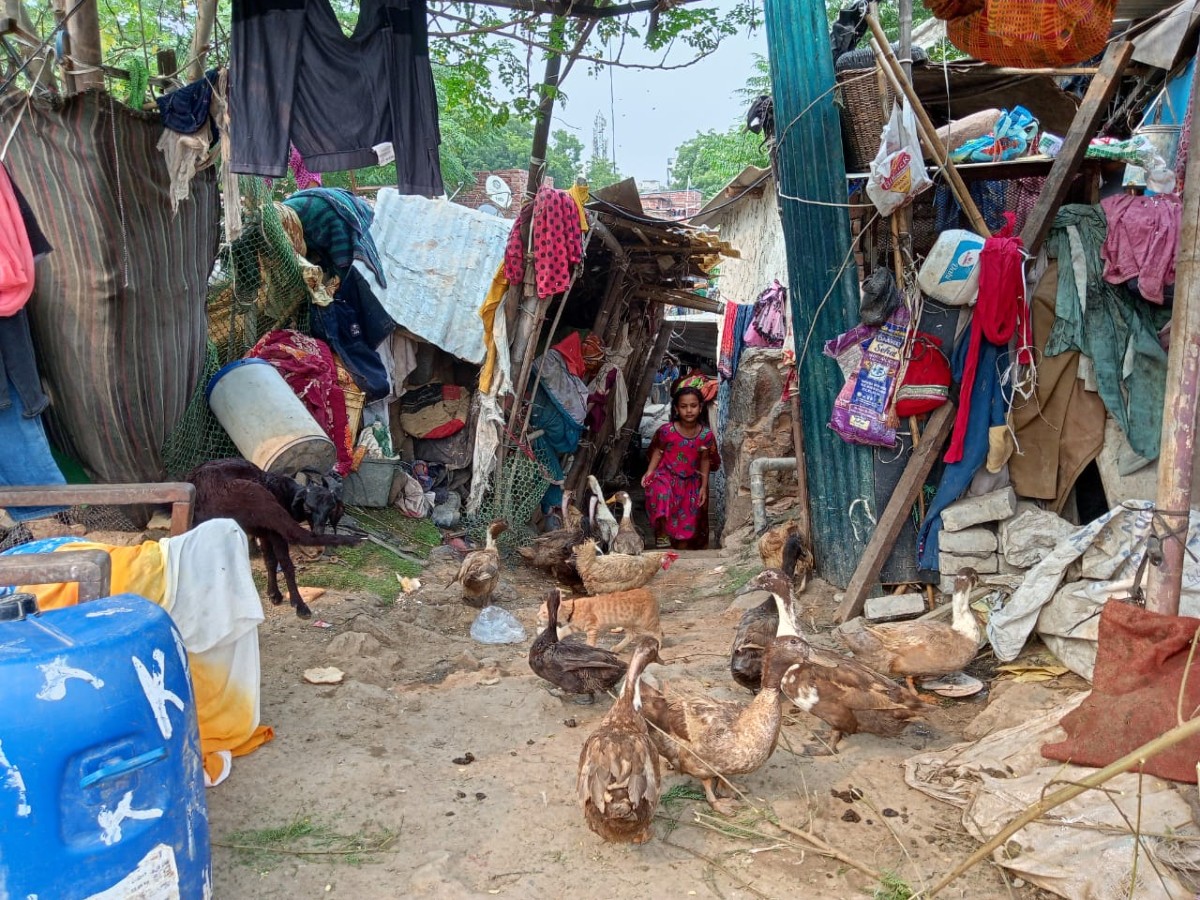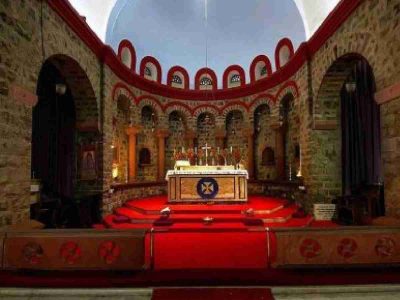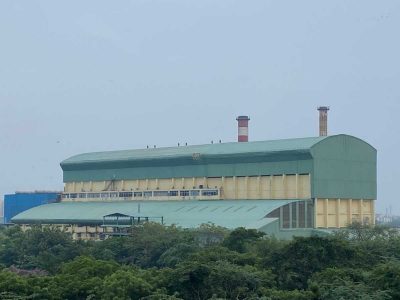Around 13 kilometres from Chittaranjan Park, an affluent locality dotted with lavish houses, lies a derelict Bengali Basti with close to 10,000 people from the community – mostly migrants from West Bengal’s Cooch Behar district.
Often taunted as “illegal Bangladeshis”, the slum dwellers possess valid Indian identity cards and cast their votes in Delhi. Some continue to be voters of West Bengal. However, the residents of Bengali Basti remain largely neglected in their clustered homes, bereft of basic amenities such as safe drinking water and hygienic toilets.
Outside of countless challenges, the slum survives on local livestock, a strong community spirit cutting across religions, bonhomie during festivities and the quintessential fish-rice.
Severe water crisis
Abiron Bibi pats her goat while at the same time keeping a watch on her neighbour’s 3-year-old boy who scurries from one house to another. Pointing towards a line of small covered water tanks, she says, “We are expected to make do with 2.5 litres of water a day. A water tanker from the municipality arrives here and supplies 400 litres to 16 families every 10 days. It’s so little! It is finished in no time,” she says.
Abiron has a family of six and has been living at the Basti for 40 years. They have to separately purchase drinking water every five days and that “burns a hole” in their pockets. “We need water for everything – cooking, cleaning, washing and other bathroom purposes. Water at the common ‘shauchalay’ (toilet) is over in no time, so we have to use our own share,” she says.
Also read: The ‘crushing’ labour of guarding monuments
During monsoons, the families keep their small tanks outside to collect rainwater and “that helps a little”, even though they cannot drink it.
Talking about her herd, “These are black Bengal goats. Monish gets these from our village back in Dinhata (in Cooch Behar) in the truck he drives. He lives in adjacent Harijan basti. We have many of these goats here. They are only eaten on specific occasions, and not otherwise because they are expensive,” Abiron says.
Bengalis are known to be emotionally attached to their hearty mutton curry, which is an integral part of their community feast, its smell pervading the air during all their festivals.
While Abiron Bibi quit her cook’s job at a house in Pocket A in Vasant Kunj last year, her husband is a cart-puller and her son a vegetable vendor at the daily market. She now runs her own tea shop at Basti.
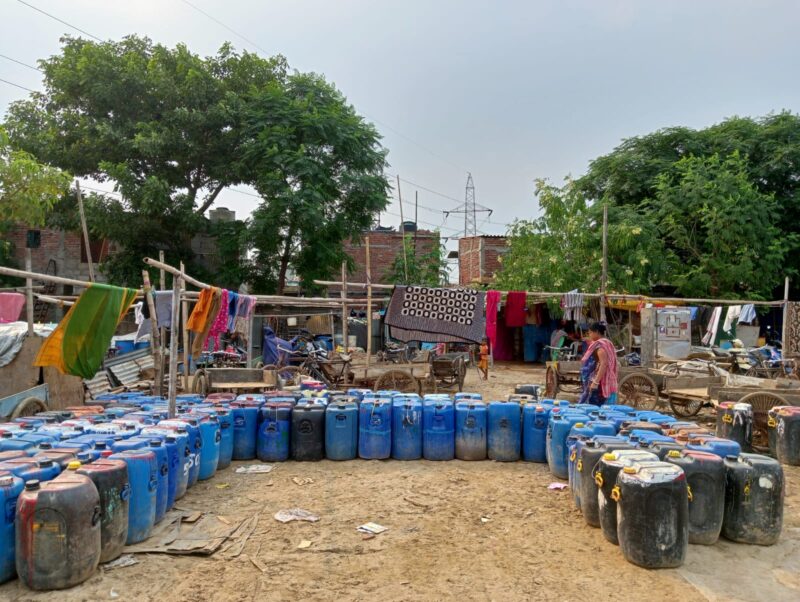
Scores of small water tanks lined up
“Joler khub akaal go ekhane (there is a severe water crisis here),” echoes Moushumi, a 32-year-old resident.
Moushumi works as a house help at Pocket B, sector-A in Vasant Kunj and runs on debt every month. “I am paid only Rs 1,300 to clean and do all the chores in a big three-room apartment. I work at four houses. My husband serves tea and does odd jobs at an office – I don’t know its name. Our whole household income is around Rs 12,000,” she says, trying to pacify her crying toddler.
Her elder son, 8, is in Class 2 at Rajkiya Pratibha Vikas Vidyalaya, where almost all the children of the Basti go to study.
Unwanted labels
Moushumi says that she finds it tough to find work because of the “Bangladeshi” tag. “We are from West Bengal. When we tell people that we are from Cooch Behar, they have no idea where that is and they easily tag us Bangladeshi,” she says. In this way, she has lost many opportunities.
However, she is content with the people she is working for at present. “They are nice people and provide tea and snacks, which I sometimes get for my son,” she chuckles.
For most of the residents, the “Bangladeshi” label has become a roadblock. While it bogs Moushumi down, Anura chooses not to work at such houses. “Tagor bashaye amra jai na (we don’t go to their houses),” she says.
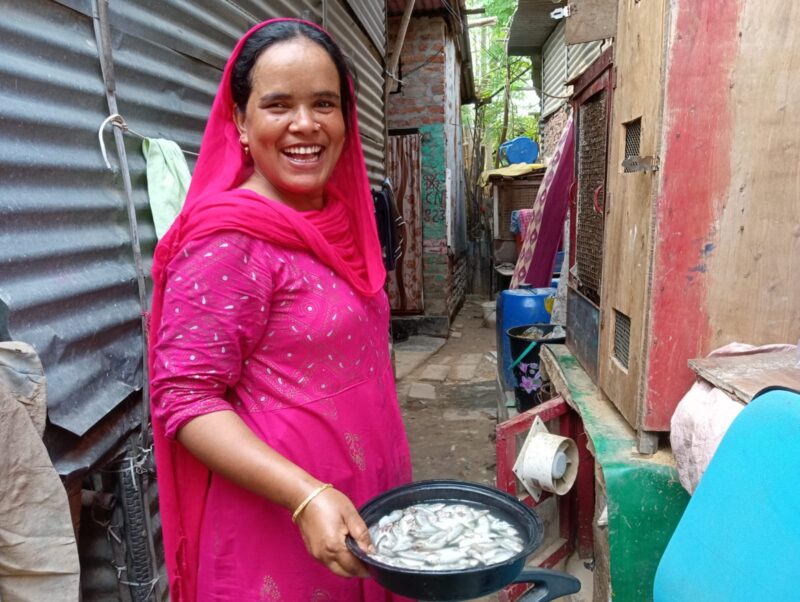
A woman carries freshly scaled fish in a bowl to her jhuggi for lunch
Twenty-five-years ago, she tagged along with her husband to Delhi “for a better life” with her 12-year-old son and 5-year-old daughter. Her husband works as a gardener at a farmhouse in Chattarpur.
Clad in their aatpoure saree (a typically Bengali way of draping the garment) ost of the women in the Basti work as house helps or cooks at various houses in the DDA flats at Vasant Kunj.
“People hear our accent and question us if we are really from West Bengal. Especially when we tell them that we are from the Bengali Basti, they look at us suspiciously. Even worse for Bengali Muslims,” she says.
“When people from Cooch Behar began relocating to this slum, it initially had few Bangladeshi migrants, but now no one apart from people from West Bengal live here,” she adds.
The residents say that officials from the administration come once a year to check their papers and ask them to produce their identity cards.
Apart from battling prejudice, Anura says that overcoming the language barrier was a big challenge for her and many other Bengalis who moved to Delhi from Dinhata, Cooch Behar. “Initially, we did not understand any Hindi. It took me close to seven years to properly grasp the language. But even today, I am not fluent,” she says.
Along with the language barrier, the culture shock “was tough” to manage. “I did not know how to cook their food when I moved here. So, I was often scolded for not being good at my job at these houses, but then my mother-in-law helped me,” says Ashima, wife of Anura’s son.
Heaps of garbage
As one enters the slum, heaps of garbage is all that meets the eye. The decrepit houses are clustered in the middle, separated by narrow alleys around the dump yards.
“Earlier it was worse, actually. Two years ago, they cleaned some heaps, but not fully. People who live across the streets and those running shops outside the basti come to throw garbage here. No one listens to us when we object,” says Anil, sitting in a tattered ‘mora’ (cane stool), outside his house.
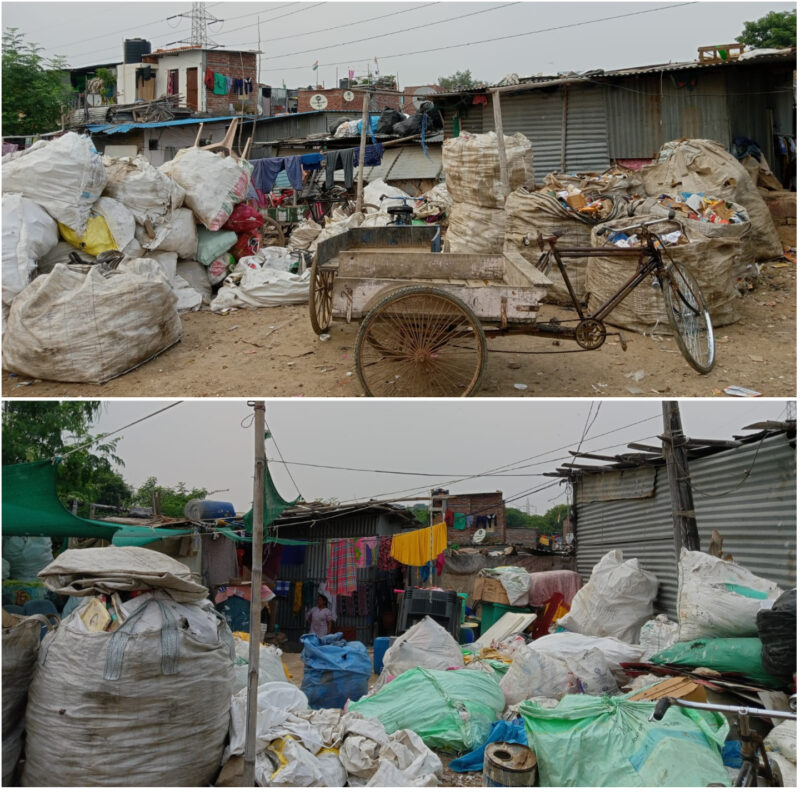
Only heaps and heaps of garbage surrounding their houses. The municipality “hardly clears” them.
“Once in several months, a cleaning truck comes, but they never empty the garbage heaps,” he adds. “We are used to living like this now and try to keep our houses clean as much as possible,” Rijwan, Anil’s neighbour, says.
The common Shauchalay, built just two years ago, has been constructed right in the middle of garbage and residents sometimes have to jump over these heaps.
During heavy rains, water mixed with garbage enters their houses and sometimes spoils the raw food that is often kept on the floor.
Submerged houses
While the monsoon brings relief amid the usual water crisis, its wrath submerges their ramshackle homes – sometimes leading to collapse.
“When it rains incessantly, we cannot even send our children to school because everything is flooded. Our bed goes under the water. We usually take refuge at elevated houses,” says Moni, who sells milk.
Every monsoon, children fall sick for days with fever and diarrhoea, he says. “They also lag behind in studies because they miss classes. Will we save our lives, homes or send them to school? So much is at stake,” he laments.
The residents complain that no one from the municipality comes to improve the situation during monsoons. “But we vote in every election here,” Moni says.
High community spirit
Huddled up at a bicycle repair shop, Poresh Robi plays cards with his four friends as cups of tea lie around. “We celebrate all the festivals together. For example, if we have a wedding at a Muslim friend’s house, we Hindus will go to attend and give our blessings and vice versa. There is no segregation there,” says Poresh, the owner of the shop.
“But we cook the food for Hindus and Muslims separately, even though we eat and celebrate together,” says Mominul, one of Poresh’s friends. “All this Hindu-Muslim enmity is outside our gates, here we are brothers,” he says.
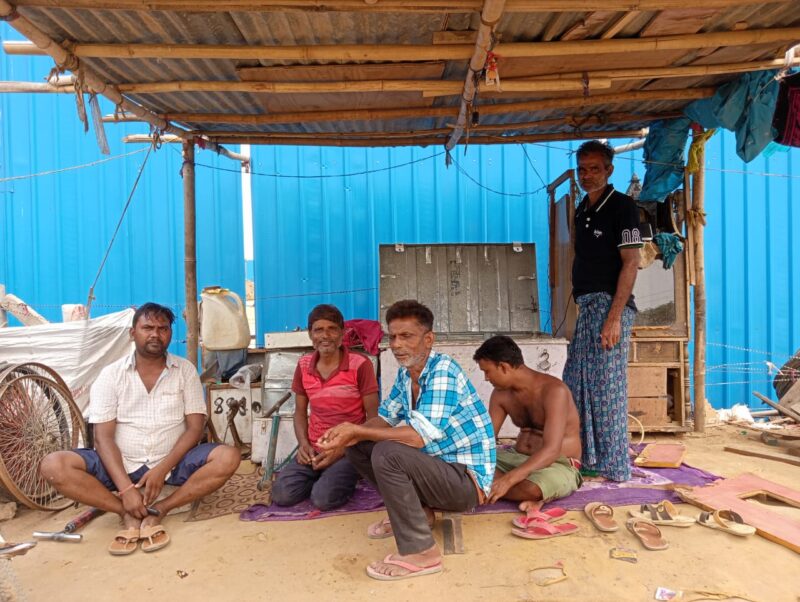
Poresh (in red t-shirt) and his friends at his bicycle repair shop
For the residents of the Bengali Basti, Kali Puja and Eid are celebrated with similar pomp and glory. “Just like our Muslim brothers participate and help us during Kali Puja, we do the same when it’s Eid. To celebrate Durga Puja, one needs money toh amra mone monei puja kore ni (so we worship the Goddess in our minds),” Poresh says.
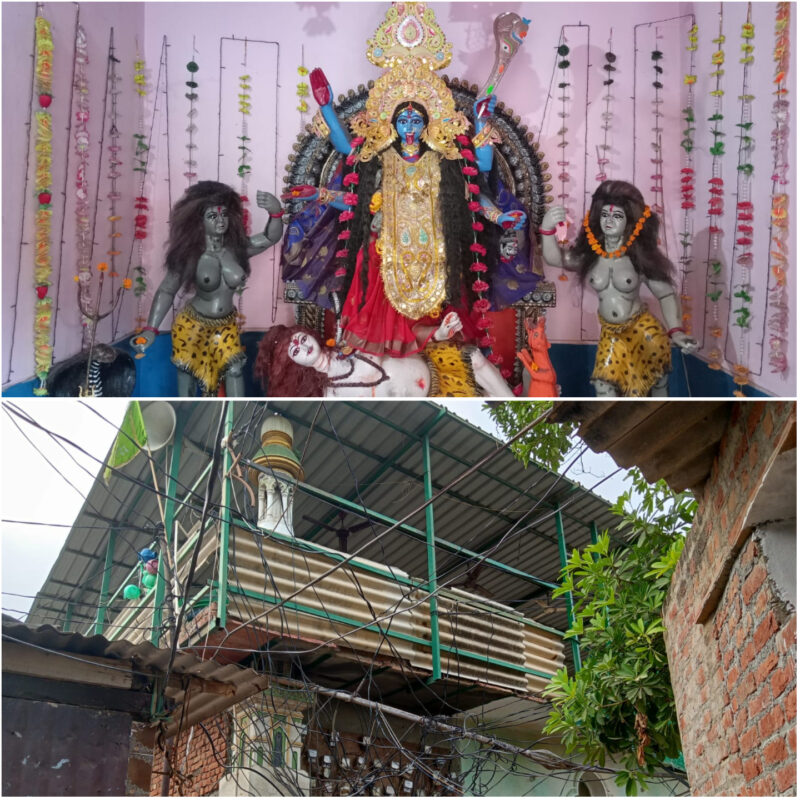
The Bengalis at the basti have built their own mosque called the Madina Masjid and a temple for their beloved Goddess Kali.
Goats are sacrificed during both Kali Puja and Eid. Through the lanes of the basti, livestock — hens, chicks and ducks – can be seen running around. While women are spotted scaling fish, the sellers, who reach Ghazipur mandi early in the morning to fetch their fish, have shut shop for their afternoon siesta – an intrinsic part of a Bengali’s life.
For most of the inhabitants of Bengali basti, beyond daily challenges resulting from poverty, the “Hutt Bangladeshi” taunts rings in their ears, causing great discomfiture.
Instagram: instagram.com/thepatriot_in/
Twitter: twitter.com/Patriot_Delhi
Facebook: facebook.com/Thepatriotnewsindia

